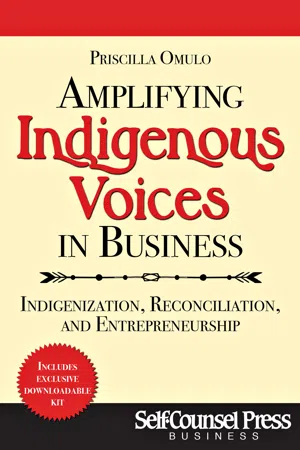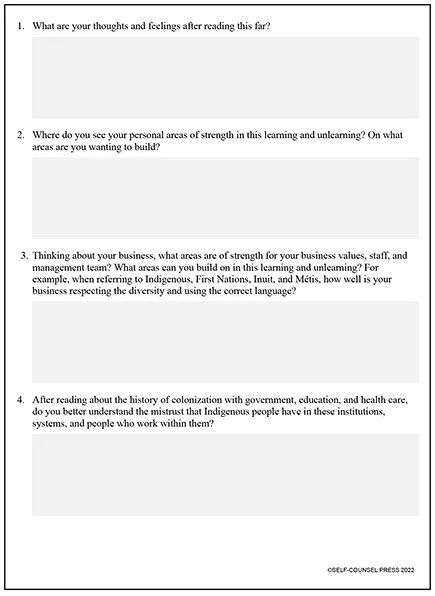![]()
CHAPTER 1
Why Indigenize? Some Background Information
This chapter will delve into the roots of systemic racism and racism, and the laws and acts that uphold or aim to dismantle our current systems. If you wonder why we needed the Truth and Reconciliation Commission or why you should Indigenize, this chapter contains more background information.
1. The Oppression Tree
The Centre for Community Organizations came up with the metaphor of the Oppression Tree (coco-net.org/wp-content/uploads/2018/11/TheOppressionTree-1-1.pdf, accessed October, 2021). Imagine a tree with deep roots, a strong trunk, and many branches. The roots are systemic issues, the trunk one’s practices and beliefs, and the branches and leaves are the visible outcomes. Putting this idea into practice for Indigenization purposes, the roots would be colonialism, white supremacy, and capitalism. The trunk or supporting structure would be government and our education, health care, and judicial systems. The branches are the employment opportunities, educational opportunities, family norms, and societal beliefs.
1.1 Roots
The roots of racism and systemic racism stem from colonialism, white supremacy, capitalism, and patriarchy. Until the roots are dug up the system will continue to grow and thrive on racism, oppression, and discrimination, and there will not be equity. The practices of decolonization and Indigenization, and Truth and Reconciliation will help dig up these roots and plant seeds of promise of a more equitable society.
1.2 Supporting structure
The roots uphold the structure of this tree and the structure forms around government policy and laws, institutional rules and regulations, and certain media and social norms. Together the roots and the supporting structure of the trunk develop a society that strengthens white privilege. Spaces and places can implement Indigenization strategies, and can work towards Truth and Reconciliation but when doing so there has to be an understanding that the system that was designed is not capable of supporting this transition. It will have to break. Breaking the trunk and digging up the roots will kill this tree but it will need to be dismantled to be able to build a new structure.
1.3 Branches and leaves
The branches and leaves on the Oppression Tree are what can be seen in day-to-day living. The interpersonal discrimination and hostility, physical/sexual aggression, insults and intimidation, racial profiling, and housing and employment discrimination can be experienced by a Black, Indigenous, or person of colour.
2. Racial Profiling
Racial profiling is when someone takes a stereotype and then treats someone differently because of it. This can be due to age, race, ethnicity, religion, place of origin, or a combination of any of these.
Racial profiling examples:
• Being followed while shopping because of the colour of your skin; being asked to leave an establishment or pay before service but other people aren’t asked to do the same.
• Landlords not renting, renting at higher rates, and/or asking for more in an application.
• Being denied healthcare or given inadequate health care.
• Not obtaining a position of employment qualified for, not promoted, paid less.
• Higher rates of police encounters, criminalization, incarceration, police violence.
• Higher rates of sexual assault, physical assault, murder, missing people.
• Lack of access to education or educational supports from primary through postsecondary.
3. The Indian Act
In Canada, the Indian Act is a prominent legal entity that aids in establishing the roots of systemic racism in this country. There are a number of resources that are listed on the downoadable kit which can be accessed through a link printed at the end of this book for you to research and read to best understand the history and context. What will be mentioned here is a brief timeline for you to better understand that these things happened not “a long time ago,” that it is still happening today, and how this will impact the work you do with your business and community.
The Indian Act was created in 1876; this was an attempt to assimilate First Nations into “Canada” as a colonial country. There are acts of segregation, oppression, and anti-Indigenous racism that were forced upon people under the Indian Act.
First Nations were not allowed to practice their ceremonies, and cultural regalia were taken away. The treaties that were signed were not properly explained and many times were misleading. There were no economic opportunities to gain wealth or even meet basic survival needs. Employment, trading, leaving the imposed reservations were limited if any access was granted at all. The system was designed to establish poverty in, and oppression and genocide over the Indigenous populations.
In 1920, as shown in Table 1, residential schools were made into law. This is an important aspect to Canadian history to understand because it is with this law that many Indigenous individuals and families were harmed, and where the whole Truth and Reconciliation attempt comes from. The last residential school did not close until 1996. This is significant because there are many arguments that this was “a long time ago” and “why don’t people get over it”?
Table 1: 1900–2000 Timeline
4. Residential Schools
First Nations children were often forced to attend residential schools, a system that was designed to “remove the Indian from the child.” Children were taken from their home and family and were not allowed to speak their language. They were often physically and sexually abused. Many children died while at the schools or due to circumstance while running away trying to leave and return home. Upon running away many children would starve to death or succumb to the elements such as heavy rains or snow.
5. Indian Day Schools
Indian day schools were places for First Nations, Inuit, and Métis children. They were similar to residential schools in the fact that they were established to “assimilate” Indigenous children. Many children experienced physical, sexual, and verbal abuses similar to what was experienced by many in residential schools. The difference was that the children remained in their home and community while attending the schools. Close to 700 Indian day schools operated across Canada. The first Indian day school opened in the early 1860s and the last closed in Quebec September 1, 2000.
6. Indian Hospitals
Less known are Indian hospitals which were opened in the 1930s due to fears about the spread of TB from Indigenous to non-First Nations people. Most closed or were converted by the 1980s. While in operation the hospital conditions were deplorable. Children and families were segregated, isolated, experimented on, and/or restrained. Hospitals were understaffed, overcrowded, and sometimes even unlicensed.
Please take a moment to reflect on what you’ve learned from this book so far, and fill out Questionnaire 1 (also available on the downloadable kit that can be accessed through the link printed at the back of this book).
Questionnaire 1: Self-Reflection Part 1
7. Empathy versus Sympathy
There is a TED talk by Brené Brown that highlights the difference between empathy and sympathy very well. She mentions that empathy is about —
• perspective taking, recognizing another’s perspective as their truth;
• staying out of judgment;
• recognizing emotion in other people; and
• communicating this recognition of emotion in other people.
“It is about connecting with something within yourself that knows that feeling,” she said.
This is crucial to distinguish the difference because understanding the TRUTH of Indigenous experience with colonization in Canada is not about bringing sympathy but to build empathy, understanding, and a place of growth to build trust and reconciliation. This work can only be done with empathy, sincerity, honesty, time, and openness.
Further reading and understanding of other calls to action and recommendations will be needed before your business takes the next steps. This is important because now that you have begun the work to truth there is an opportunity to begin your work with reconciliation. To meet these recommendations and calls to action you first must know what they are, where they come from, and how it impacts your business.
8. Truth and Reconciliation
As mentioned, in 2007 the largest class action settlement in Canadian history began. This would require the government to begin the Truth and Reconciliation commission. This commission would travel across Canada hearing from more than 6,500 witnesses until 2015. The final report would include 94 calls to action.
9. United Nations Declaration on the Rights of Indigenous Peoples (UNDRIP)
The United Nations Declaration on the Rights of Indigenous Peoples (UNDRIP) was adopted by the General Assembly in September, 2007. This includes 46 articles relating to culture, identity, religion, language, health, education, and community. In 2019, British Columbia passed legislation: the Declaration on the Rights of Indigenous Peoples Act (DRIPA). This legislation was developed with the First Nations Leadership Council which includes the BC Assembly of First Nations, the First Nations Summit, and the Union of BC Indian Chiefs.
Truth and Reconciliation and UNDRIP are tied together because Call to Action #92 includes the legislation and implementation of UNDRIP. These two are not standalone processes when calling the government on the action on the rights for Indigenous people in Canada. There are many injustices that are happening across the country. Below is a (not fully inclusive) list in no order of significance:
• Lack of access to clean drinking water
• Environmental protection/Indigenous consultation (pipelines, waterways)
• Murdered and missing Indigenous women and girls
• Disproportionate rates of children in the care of the Ministry of Children and Families
10. Clean Drinking Water
Imagine your life here in Canada and you experience waking up in the morning, taking a shower, brushing your teeth, and having a glass of water (OK, tea or coffee, maybe). This is not the experience for many Indigenous people in Canada.
Going back to the United Nations, in July 2010 the UN declared water and sanitation a human right. Recalling the daily routines connected to water and sanitation, it is understandable that it is a human right because clean water is intersectional with our health, overall wellness, and economic well-being.
Economic well-being is not just about having what you need to get out there and work to support yourself or your family. Imagine what it is like to have to buy water bottles and/or jugs of water for everything you do? Not only the morning routine but also your cooking, cleaning, laundry, and handwashing? Especially in this time of COVID-19 when proper handwashing is so important. One layer deeper, thinking about the importance of not spreading COVID-19 in isolated, rural, Indigenous communities that will already have struggles with transportation, access to health care, access t...



